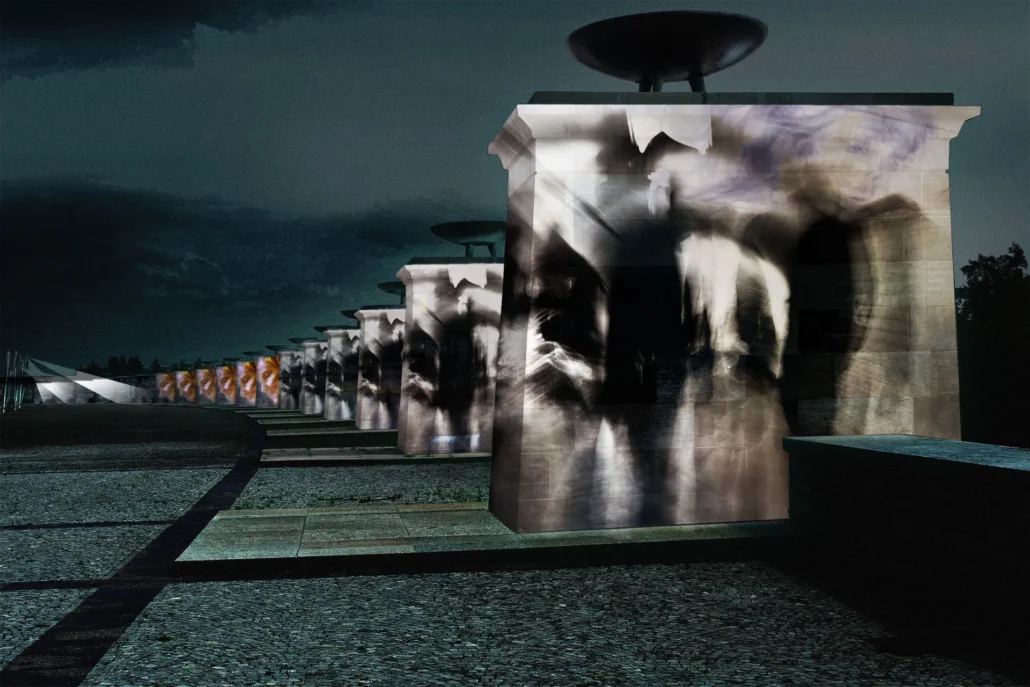
Empathy
Genius Loci Weimar 2024
The Avenue of Nations at the Buchenwald Memorial becomes a human path of fate
As we walk along the pylons, we are immersed in an imaginary world of images and sounds. The three-part installation of slowly merging images (Liquid Image) and a soundscape of noises, voices and musical composition leads us beyond the commemoration of the victims into the here and now and thus also to self-reflection.
- 30.08. – 01.09. 8 pm – 1 am at the Buchenwald Memorial
- Length: 27 minutes: 3 parts of 9 minutes each, each part runs in a continuous loop
- Projection on 18 pylons along the 300 metre long Avenue of Nations
- 18 projectors / 36 sound stations / 2 spotlights

Part 1: The victims of Buchenwald
Pylons 1 to 6
We accompany the people from the arrival at the railway station in Weimar to the Buchenwald camp gate. We get an idea of their lives in the concentration camp from the few remains of their existence. Their annihilation and extermination in the crematorium is not the end, for we encounter their souls in shadowy silhouettes and their voices cannot be overheard. The victims of Buchenwald seem to emerge from the anonymous stone of the pylons to make contact with us.

Part 2: Buchenwald was everywhere
Pylons 7 to 12
We become witnesses to the often murderous forced labour in the Buchenwald camp and its outposts. The mission of „never again“ that emanates from Buchenwald has not been fulfilled to this day. In numerous places around the world, people suffered and continue to suffer from the cruelty and arbitrariness of totalitarian systems. We also honour the memory of these victims. Their souls permeate the entire installation in the form of silhouettes and as a melody played by instruments from different regions of the world.

Part 3: Buchenwald is everywhere
Pylons 13 to 18
We are in the here and now. Refugees make the conflicts of the world visible in the currently peaceful Western Europe. We meet them at railway and metro stations and witness their flashbacks. Memories of their homeland are mixing with their experiences of flight.
In the end, we return to Buchenwald
A person of today steps out of the crematorium into the light. A symbol of salvation or death? Everyone can answer that question for him or herself.
This self-reflection is intensified by the fact that spotlights illuminate the passing visitors from behind so that their own shadows are laid on the silhouette of the person in the installation.
Frequently asked questiones about EMPATHY
We took all the photos ourselves – except for one, which was provided to us by the Buchenwald Memorial. The majority of the photos were taken in Buchenwald at the end of June 2024 after we were informed that we had won the competition. We also included photos from trips to various countries in EMPATHY.
Yes, over the past few years we have developed a special photography technique that produces both sharp and motion-blurred images. You can find out how this works in the Questions to the AC photographer on our website.
Not really, because we compose a so-called liquid image from the single images. Through the technical process of cross-fading, the photographs communicate with each other, merge and create new images. Recognising the separate images is no longer important. Instead: Associations, emotions, new perceptions.
The sound was composed especially for EMPATHY. It consists largely of noises and voices that we recorded at the Buchenwald Memorial and Weimar railway station. In order not to disturb the peace and quiet of the memorial, we created and recorded loud noises, such as those of the concentration camp, in our studio. Historical sounds, such as steam locomotives, come from sound archives. We combine these concrete sounds with the abstract world of music. Simple motifs and melodies that expand into orchestral compositions in the final part. Some instruments were recorded analogue, others were recorded with virtual sound generators and sample libraries.
The sound tells the story or stories. It adds another narrative level to the images. Image and sound are inseparably linked. Images evoke associations. Sound creates emotions – and vice versa. Together they reinforce and multiply the possible perceptions. Above all, EMPATHY tells the story of the people of Buchenwald. There are only a few remnants of their existence that we can show in images. But with the help of sounds, voices and melodies, we can trace and perceive their lives in Buchenwald.
There are various voices generated by AI. For example, we had a letter written in Dari by a refugee from Afghanistan to his children. The father explains to his children the reason for his flight and how sad he is that he had to leave them. We wanted to preserve the authenticity of this letter and used the original language, read out by a male and a female voice. The use of AI was very helpful for this. Incidentally, the letter can be heard in the 3rd part of EMPATHY.
Yes, the Morse code means: „Americans liberate Buchenwald concentration camp.“
A projector is positioned in front of each of the pylons, aligned at an angle of 45 degrees to the front right edge. This allows us to project the liquid image onto the front and right side of the pylon and minimise loss of resolution, sharpness and brightness.
Boxes will be positioned on both sides of the „Street of Nations“ so that visitors can move through a sound space and perceive stereo effects.
Do you have any further questions? We will be happy to answer them.
Area Composer
Dorothee Pilavas – Art Projecter, Dortmund – +49-1522-8619131
Ronald Gaube – Composer / Sound, Düsseldorf – +49-170-7528204
Peter Hölscher – Composer / Image, Leverkusen – +49-175-2418227
Atelier: Reuschenberger Mühle, Alte Garten 61, 51371 Leverkusen, Germany
info@area-composer.de
Headquarters and Postal Address: Umbra, Mankhauser Str. 1, 42699 Solingen, Germany